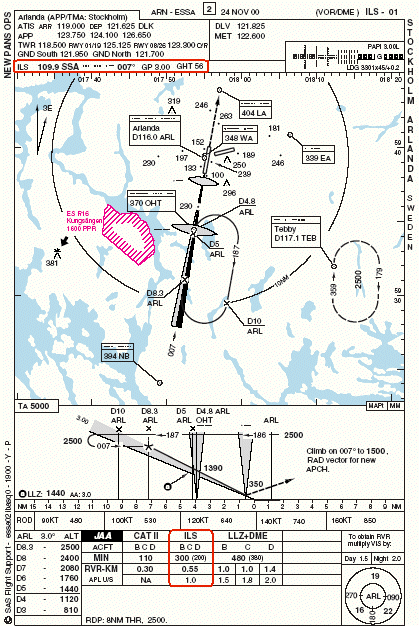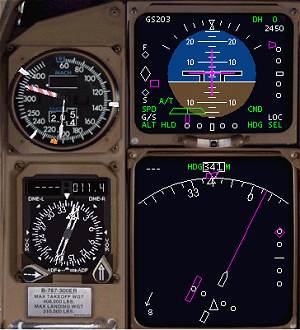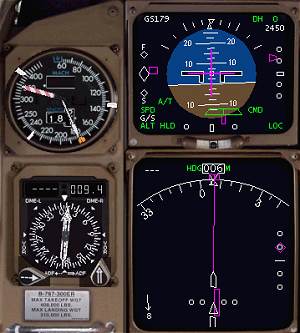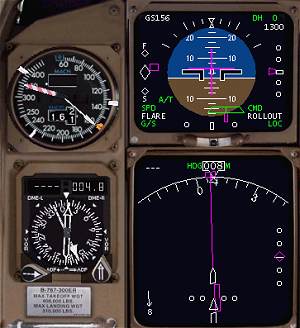ILS Approach¶
There are three different different weather criteria when performing an ILS approach.
- CAT I (CATEGORY ONE)
- A precision instrument approach and landing using ILS with a "decision height" DH (vertical distance above ground) not lower than 200ft with a "runway visual range" RVR in the touchdown zone, not less than 550m.
- CAT II (CATEGORY TWO)
- A precision instrument approach and landing using ILS with a DH below 200ft but not lower than 100ft and RVR of not less than 300m on the first segment of the runway.
- CAT III (CATEGORY THREE) Divided into
-
- CAT IIIA
- A precision instrument approach and landing using ILS with a DH below 100ft and RVR of not less than 200m on the first segment of the runway.
- CAT IIIB
- A precision instrument approach and landing using ILS with a DH below 50ft or no decision height and RVR lower than 200m but not less than 75m.
ILS approach CAT I
The ILS frequency, Identification signal and inbound course can be found in the left corner of the IAL chart. GP 3.00 is the Glide Path angle and GHT is the Glide Path Height above Threshold. GHT must be minimum 50 in order to do an autoland.The minima is presented at the bottom of the IAL. ILS stands for CAT I. Aircraft type is C and minima 300ft (this is an Altitude referring to local QNH) and visibility 0.55 (550 meters).
Finally there is the vertical drawing of the approach. Initial altitude is 2500ft, GP capture at 8.3NM, Outer Marker OHT must be passed at or above 1390ft. Also the Go Around procedure (RWY heading to 1500ft).

The most common way to establish on an ILS approach, is via radar vectoring.
ATC will vector on to an intercept heading of 30º to the ILS inbound course. At
ESSA Stockholm Arlanda RWY01 this will mean 340º. The speed is normally 250kts
IAS below FL250. During radar vectoring it´s rather common for the ATC to
request a lower speed in order to keep the separation to other aircrafts. In
case the speed is free, start to reduce to 210kts some 13 NM out. Then reduce
further to 180 around two NM before GP capture.
- VHF NAV1 - 109.9/007 (ILS and inbound course)
- VHF NAV2 - 116.0 Arlanda VOR to get the DME.
- ADF - OHT
- During radar vectoring fly Heading Select. The altitude should be 2500ft well before GP capture (the AP will not capture the GP from above).
- Arm the A/P for ILS after receiving "Clear for the approach" by the ATC. This is normally done by pressing APP or ILS button dependent panel in use.
- Minima is set on the feet altimeter. Measured with reference to local QNH.
A closer look at the instruments
The speed and flap settings in this example, are for a CAT C aircraft MD80.
This is before Localizer capture.
Speed bug (red) is set to 210kts, one white bug to "Clean speed" 230kts the other to final speed "threshold" 135kts the A/T is engaged in speed hold.
The actual Ground Speed (GS)is 203kts and altitude is 2450ft.
The heading is 340º and the A/P is armed for LOC and GP capture. We are flying in Heading select (HDG SEL) and flaps at 11º.
Also observe that the A/C attitude is 4-5º nose up, which is normal for this speed and configuration.
DH 0 is the Decision Height on the Radio Altimeter (not used during CATI approach).

Localizer capture and the A/P will keep the 007º inbound.
Speed is set to 180kts and the glide path index is one dot up, time to lower the gear and reduce to 160kts and flaps to 15º. This speed shall normally be maintained to the OM. After "gear down and locked" we may arm the Autospoiler.

Fully established and just passed OHT, the Outer marker. The single needle on the RMI pointing backwards, while the double needle still pointing forward (towards ARL). DME reading is 4,8 which also corresponds to the OM and the Altitude is 1300. When passing the OM or equivalent position (might also be a DME distance) the altitude must be checked against the value on the IAL.
Time to set flaps in landing position and reduce to final approach speed.
At minima (300ft) you must have the Approach light or the Runway in sight in order to continue the approach. Otherwise -- GO AROUND.
Company policies.
- CAT I
-
Minima is set on the FEET ALTIMETER and thus measured relative local QNH.
- Autopilot or manual flying approved.
- CAT II
-
Minima is set on the RADIO ALTIMETER and thus measured relative ground.
- Autopilot shall be used.
- In case of inadvertent disengagement below DH and before touchdown the approach may be continued provided visual reference are maintained.
- Max crosswind component 10kts.
- Autopilot shall be used.
- CAT III
-
Minima is set on RADIO ALTIMETER.
- Autoland is mandatory.
- In case of inadvertent disengagement below DH and before touchdown - GO AROUND.
- Max crosswind component 10kts.
- Autoland is mandatory.
- Use of Autoland
-
Autoland approved for all runways except when otherwise stated on IAL.
- GHT (Glide path Height above Threshold) must be 50ft or more.
- An offset Localizer must not be used.
* Turkish Virtual Education Department.We Appreciate ''SCANDINAVIAN VA'' for Sharing Their Training Documents with Us
- GHT (Glide path Height above Threshold) must be 50ft or more.